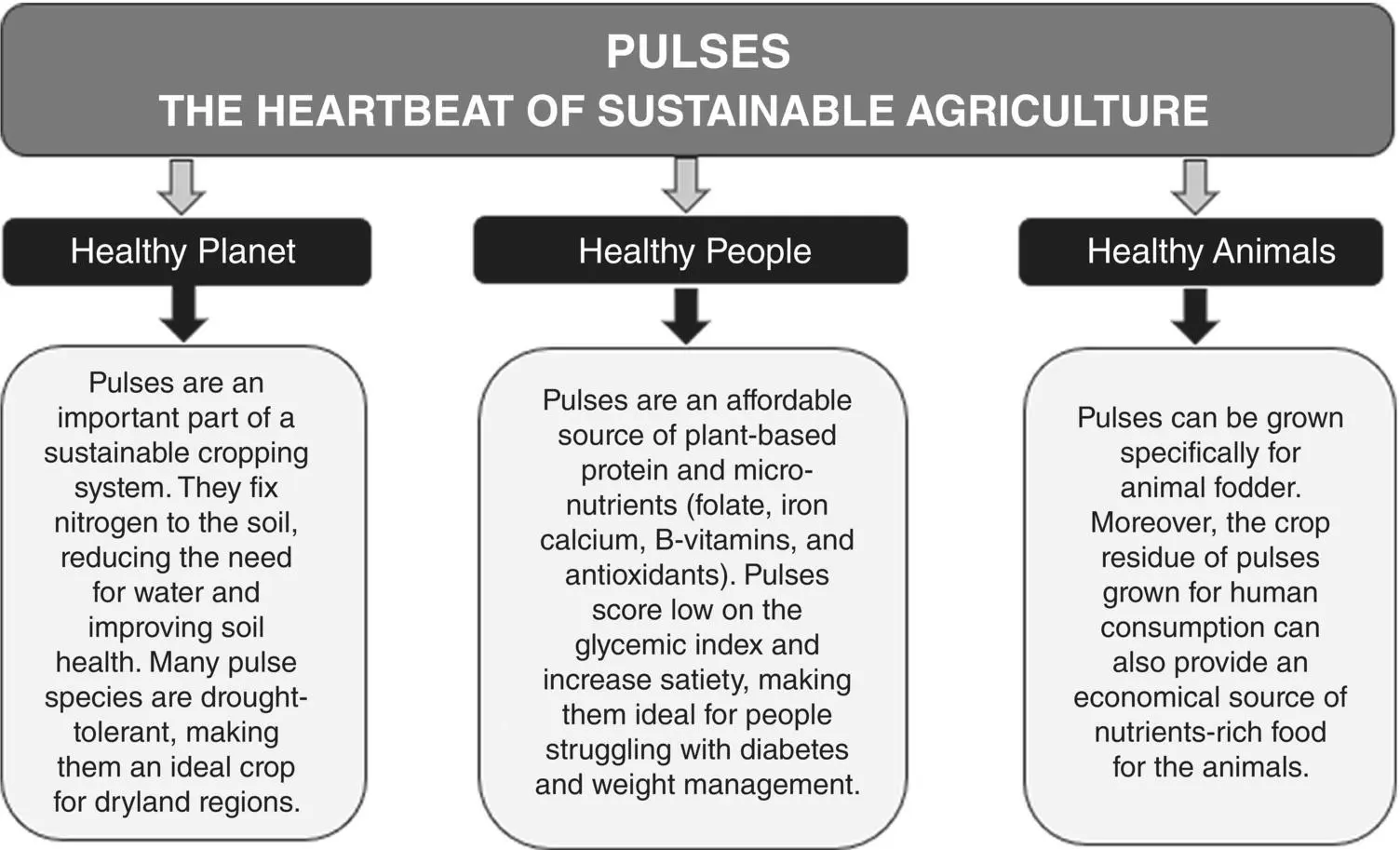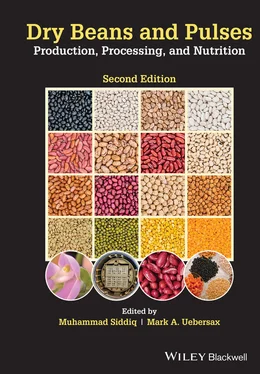Dry Beans and Pulses Production, Processing, and Nutrition
Здесь есть возможность читать онлайн «Dry Beans and Pulses Production, Processing, and Nutrition» — ознакомительный отрывок электронной книги совершенно бесплатно, а после прочтения отрывка купить полную версию. В некоторых случаях можно слушать аудио, скачать через торрент в формате fb2 и присутствует краткое содержание. Жанр: unrecognised, на английском языке. Описание произведения, (предисловие) а так же отзывы посетителей доступны на портале библиотеки ЛибКат.
- Название:Dry Beans and Pulses Production, Processing, and Nutrition
- Автор:
- Жанр:
- Год:неизвестен
- ISBN:нет данных
- Рейтинг книги:5 / 5. Голосов: 1
-
Избранное:Добавить в избранное
- Отзывы:
-
Ваша оценка:
- 100
- 1
- 2
- 3
- 4
- 5
Dry Beans and Pulses Production, Processing, and Nutrition: краткое содержание, описание и аннотация
Предлагаем к чтению аннотацию, описание, краткое содержание или предисловие (зависит от того, что написал сам автор книги «Dry Beans and Pulses Production, Processing, and Nutrition»). Если вы не нашли необходимую информацию о книге — напишите в комментариях, мы постараемся отыскать её.
The second edition of the most complete and authoritative reference on dry beans production, processing, and nutrition available Dry Beans and Pulses: Production, Processing, and Nutrition
Dry Beans and Pulses: Production, Processing, and Nutrition, Second Edition
Dry Beans and Pulses Production, Processing, and Nutrition — читать онлайн ознакомительный отрывок
Ниже представлен текст книги, разбитый по страницам. Система сохранения места последней прочитанной страницы, позволяет с удобством читать онлайн бесплатно книгу «Dry Beans and Pulses Production, Processing, and Nutrition», без необходимости каждый раз заново искать на чём Вы остановились. Поставьте закладку, и сможете в любой момент перейти на страницу, на которой закончили чтение.
Интервал:
Закладка:
LEGUMES AND SUSTAINABILITY OF AGRICULTURAL SYSTEMS
Pulses provide environmentally sustainable source of nutrients‐rich food for humans and animals, as summarized in Figure 1.7 (GAP.org 2016). Sustainability of agricultural systems embrace long‐term environmental consequences that transcend short‐term productivity and efficiency objectives. A truly broad‐based construct associated of sustainability promotes the integration of food production practices and social needs. Thus, globally, agriculture sustainability must be considered as a social process besides technological practices and innovations. The production of legumes (dry beans and other pulses) has a rich and diverse history and serves as a global food resource within both industrially developed nations and indigenous populations. Since producing plant‐based foods are by far more environmentally conservative than the animal‐based ones (Gogoi et al. 2018), legumes will continue to play an increasingly major role to meet human food needs. Several elements of agricultural sustainability are clear or inherent in the production of pulses due to the considerably high total calorie and protein contents derived per unit of energy input:

Fig. 1.7. Pulses as environmentally sustainable food source for healthy people and healthy animals.
Source: Adapted from GAP.org (2016).
Nitrogen fixing. Legume crops are distinguished by their unique ability to “fix nitrogen” and thus have significant impact on their need for soil‐borne nitrogen (Liu et al. 2011). By contrast, typically, major crops such as corn, wheat, and rice require added nitrogen to be productive and yield sufficiently to be economically viable. A progressive crop rotation is essential to maintain vital soil health and for managing weeds and disease pressure. Growers are generally diversified among several crops (e.g., corn, wheat, soybeans) – they are not exclusively dry bean producers on their farm acreage. Therefore, most fields are used for dry beans or other pulses every 3–5 years depending on the prescribed rotation. Not only do pulses directly benefit from the root‐nodulation encapsulated symbiotic bacteria, rhizobia, that generate soil nitrogen, but there is significant carryover nitrogen levels that benefit the subsequent rotation crop.
Drought tolerance. Dry beans and other pulses are much more drought tolerant (GAP.org 2021) than many other major crops, particularly cereal crops. Dry beans require less total water and significantly less irrigation than alternative crops since arid and semi‐arid lands require the use of supplemental water to sustain plant growth (Ye et al. 2018). Dry beans require differential levels of water during various stages of growth, which is precisely determined and controlled. Moreover, dry beans and other pulses will reproduce seed under the most drought stressed conditions where the cereal grains will fail to reproduce.
Field drying. Legumes are efficient at harvest because they require no or very limited external/additional seed drying as is common with corn, wheat, rice, and other cereal grains. Beans and other pulses are naturally dried to a moisture content of around 18% prior to harvest. By contrast, typically, corn and cereal grains require artificial, forced air drying, which requires huge fossil fuel (propane) energy input to reduce moisture content suitable for stable storage without mold/bacterial development and spoilage.
Harvesting efficiency. Dry beans are increasingly produced from plants possessing an upright architecture that allows for more rapid drying and direct cutting with mechanized combines rather than traditional pulling of the plants and windrowing for air drying. This energy‐efficient innovation reduces overall fuel consumption compared to traditional harvest systems and avoids multiple field passes, which compact soil thereby requiring additional energy input for tillage.
Biodiversity and productivity. Legumes are a world resource of biodiversity, providing significant land races of dry bean types providing genetic diversity within wide ranges of populations (Yang et al. 2021). The cultural practices associated with dry bean production, procurement, and preparation are very efficient. Additionally, research continues to enhance the productivity and efficiency of dry beans and other pulse crops that use reduced energy and agricultural inputs.
BEANS AND OTHER PULSES IN WORLD FOOD SECURITY
Global food security continues to be a worldwide concern. Beans and pulses contribute to world food supplies and food intake significantly. The significance of agricultural research for crop improvement and enhanced utilization of dry beans and pulses is evident through the scale and diversity of programs (Siddiq and Uebersax 2012). Under CGIAR (Consultative Group on International Agriculture Research), there are a number of research centers focusing on dry beans and pulses; e.g., International Center for Tropical Agriculture (CIAT, Cali, Columbia), International Crops Research Institute for the Semi‐Arid Tropics (ICRISAT, Hyderabad, India); International Center for Agricultural Research in the Dry Areas (ICARDA, Alleppo, Syria); and the International Institute of Tropical Agriculture (IITA, Ibadan, Nigeria). According to CGIAR (2011), “impressive gains have been made with improved common beans, developed with farmer participation through regional networks in East, Central and Southern Africa; e.g., 30–50% yield increase from 1995 to 2010. This improved bean production, while strengthening household food and nutrition security, also provides women with surplus grain to sell in local markets.
In addition, numerous other countries through their international development agencies emphasize and support similar research programs on beans and pulses improvement. Selected such agencies include: Australian Agency for International Development (AusAID), Canadian International Development Agency (CIDA), International Development Research Centre (IDRC, Canada), German Agency for International Cooperation (GIZ), Japan International Cooperation Agency (JICA), Swedish International Development Cooperation Agency (SIDA), and Department for International Development (DFID, United Kingdom).
The Food and Agricultural Organization of the United Nations (FAO) endeavored to make people more aware of the nutritional value of pulses, of their contribution to sustainability, and more reliable food by declaring 2016 as the International Year of Pulses (IYP 2016). This declaration intends to facilitate cooperation within food production systems to better use protein in pulses. The IYP 2016 aimed to heighten public awareness of the nutritional benefits of pulses as part of sustainable food production aimed towards food security and nutrition ( Figure 1.8 ).
In the United States, the USAID (Agency for International Development) has long played a role in the dry beans and pulses improvement programs globally. Significant impact has been achieved through the collaborative research support program (CRSP) efforts on dry beans, cowpeas, and pulses. Current research foci are: increasing pulse productivity through genetic improvement, increasing pulse productivity through integrated crop management, increasing pulse utilization for improved nutrition and health, and strengthening pulse value chains (USAID 2012). The Pulse CRSP contributes to economic growth and food and nutrition security through knowledge and technology generation that strengthens pulse value chains and enhances the capacity and sustainability of agriculture research institutions that serve pulse sectors in developing countries of Africa and Latin America. Overall, the Pulse CRSP supports over 30 projects in about 20 countries (USAID 2012). Figure 1.9 shows the geographical distribution of these projects.
Читать дальшеИнтервал:
Закладка:
Похожие книги на «Dry Beans and Pulses Production, Processing, and Nutrition»
Представляем Вашему вниманию похожие книги на «Dry Beans and Pulses Production, Processing, and Nutrition» списком для выбора. Мы отобрали схожую по названию и смыслу литературу в надежде предоставить читателям больше вариантов отыскать новые, интересные, ещё непрочитанные произведения.
Обсуждение, отзывы о книге «Dry Beans and Pulses Production, Processing, and Nutrition» и просто собственные мнения читателей. Оставьте ваши комментарии, напишите, что Вы думаете о произведении, его смысле или главных героях. Укажите что конкретно понравилось, а что нет, и почему Вы так считаете.












